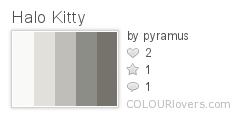Sodium Vapour
This posting is brought to you by the accidental confluence of three of my favourite websites.
I was reading the usual rants on Customers Suck! (fave #1), where people who work in retail come to vent their spleen, because if you work in retail, you have to vent from time to time or your spleen will explode. Someone was using as an avatar a picture of a kitten which I remember having seen on I Can Has Cheezburger? (fave #2), so I looked it up there, and when I found it I thought of a great name for a palette on Colourlovers (fave #3), so I made one.
Here's the picture:

Here's the palette:

Here's the question: where did the word "halo" come from?
The first words it brought to mind as I was mulling it over were "halation" and "halogen". I knew "halation" was directly related: it essentially means "halo-ing", and refers to the glare that we see, or that appears on photographic film, when a bright light shines out from behind an object. I also knew that "halogen" was Greek for "salt-forming", just as "oxygen" means "acid-forming". So, do halogen lights make haloes, or what?
They don't. Amazingly, the "halo-" from "halogen" and "halo" itself have nothing in common, even though they're both from the Greek. The "halo-" in "halogen" is from "hals", "salt"; it's from the Indo-European root "sal" that Latin took unmolested to form such words as "salarium" (originally a payment in valuable salt); English took from this the word "salary". We also got such words as "salad", "salami", "salsa", "sausage", and "sauce", because these all originally referred to foods that were salted to preserve them. From the Germanic languages we got another "sal-" word, "silt", originally a salt marsh.
"Halo", on the other hand, is from Greek "halos", the (circular) floor on which threshing took place, later anything disk-shaped, such as a shield, the moon, or the sun. It's this final sense that gives us the halo which appears over the head of anyone particularly holy.
It's worth noting that even though the sense of "halo" is irretrievably linked with roundness, as the depiction of the halo evolved in art, its shape changed. Cecil Adams has a bit about the shape of halos:
The halo thing is actually pretty intricate. There are not only plain round halos, used to signify saints, there's also the cross within a halo, used for Christ; the triangular halo, used for representations of the Trinity; and the square halo, used to depict unusually saintly living personages, such as certain scandalously underpaid journalists I could name. (Square haloes, I am obliged to report, look totally Polish. No offense.) Occasionally you also see things like the hexagonal halo, about which the less said the better.
I was reading the usual rants on Customers Suck! (fave #1), where people who work in retail come to vent their spleen, because if you work in retail, you have to vent from time to time or your spleen will explode. Someone was using as an avatar a picture of a kitten which I remember having seen on I Can Has Cheezburger? (fave #2), so I looked it up there, and when I found it I thought of a great name for a palette on Colourlovers (fave #3), so I made one.
Here's the picture:

Here's the palette:

Here's the question: where did the word "halo" come from?
The first words it brought to mind as I was mulling it over were "halation" and "halogen". I knew "halation" was directly related: it essentially means "halo-ing", and refers to the glare that we see, or that appears on photographic film, when a bright light shines out from behind an object. I also knew that "halogen" was Greek for "salt-forming", just as "oxygen" means "acid-forming". So, do halogen lights make haloes, or what?
They don't. Amazingly, the "halo-" from "halogen" and "halo" itself have nothing in common, even though they're both from the Greek. The "halo-" in "halogen" is from "hals", "salt"; it's from the Indo-European root "sal" that Latin took unmolested to form such words as "salarium" (originally a payment in valuable salt); English took from this the word "salary". We also got such words as "salad", "salami", "salsa", "sausage", and "sauce", because these all originally referred to foods that were salted to preserve them. From the Germanic languages we got another "sal-" word, "silt", originally a salt marsh.
"Halo", on the other hand, is from Greek "halos", the (circular) floor on which threshing took place, later anything disk-shaped, such as a shield, the moon, or the sun. It's this final sense that gives us the halo which appears over the head of anyone particularly holy.
It's worth noting that even though the sense of "halo" is irretrievably linked with roundness, as the depiction of the halo evolved in art, its shape changed. Cecil Adams has a bit about the shape of halos:
The halo thing is actually pretty intricate. There are not only plain round halos, used to signify saints, there's also the cross within a halo, used for Christ; the triangular halo, used for representations of the Trinity; and the square halo, used to depict unusually saintly living personages, such as certain scandalously underpaid journalists I could name. (Square haloes, I am obliged to report, look totally Polish. No offense.) Occasionally you also see things like the hexagonal halo, about which the less said the better.

0 Comments:
Post a Comment
<< Home